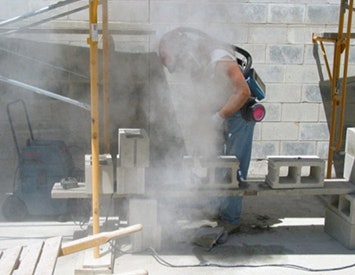 OSHA’s new regulations requiring a reduction in jobsite crystalline silica took effect September 23. Credit: New Jersey Department of Health
OSHA’s new regulations requiring a reduction in jobsite crystalline silica took effect September 23. Credit: New Jersey Department of HealthConstruction companies are now required to reduce respirable crystalline silica dust on work sites by 80 percent, on average during an eight-hour shift, following new federal regulations that took effect Sept. 23.
While less than a week in effect, the rules face a challenge before the U.S. Circuit Court of Appeals as attorneys for the National Stone, Sand and Gravel Association and the Brick Industry Association, along with several other groups, argue that the rules are unnecessary and a harsh financial burden. They say silica-related illnesses have dropped 95 percent in the past 40 years and that the required reductions are too much too fast.
The American Foundry Society and five other metal-casting trade groups have called on the Trump administration to change the rules to help their members. Many small and medium-sized plants are being hit with compliance bills of more than $1 million, which would force them to close, they say.
“Imagine a federal regulation that each year would cost 276 percent of the industry’s profits,” says a recent letter from the groups to U.S. Labor Secretary Alexander Acosta.
OSHA to ease into enforcement
The U.S. Occupational Safety and Health Administration says it will spend the next 30 days helping companies comply with the rules which are designed to prevent illnesses linked to overexposure to silica, such as lung cancer and silicosis. As long as good faith efforts are being made, the agency won’t issue citations during the 30-day period.
It will, however, consider citations for employers who aren’t making an effort, according to a memorandum by OSHA Acting Deputy Assistant Secretary Thomas Galassi. Any such citations would require review by OSHA’s national office during the initial 30-day period.
OSHA says it will focus its attention over the next 30 days on “Table 1” of the rules, which sets out required compliance options for specific tasks. Several companies have rolled out attachments for drills, saws and other cutting and boring tools ahead of the new rules to meet Table 1 requirements. The products include hollow drill bits, vacuums, water pumps and sprayers that prevent airborne dust when working on substances that contain silica, such as concrete, brick and rock.
“OSHA will pay particular attention to assisting employers in fully and properly implementing the controls in the table,” Galassi’s memo said.
OSHA: Rules will save lives
OSHA estimates the rules will save 600 workers’ lives each year and prevent 900 cases of the respiratory illness silicosis, and about 2 million workers will come under the regulations.
The regulations allow a variety of ways to comply, but OSHA views Table 1 compliance as the simplest. Otherwise, employers must come up with their own method of measuring silica dust and reducing it to the required permissible exposure limit (PEL). The PEL is now 50 micrograms per cubic meter of air during an eight-hour shift, down from 250.
Compliance, however, does not stop with Table 1. OSHA also requires construction employers to do the following:
- Establish and implement a written exposure control plan.
- Designate a competent person to implement that plan.
- Restrict housekeeping practices that expose workers to silica when there are feasible alternatives available.
- Offer medical exams, including chest X-rays and lung-function tests, every three years for workers required to wear a respirator 30 or more days a year.
- Train workers on ways to limit silica exposure.
- Keep records of workers’ silica exposure and medical exams.












